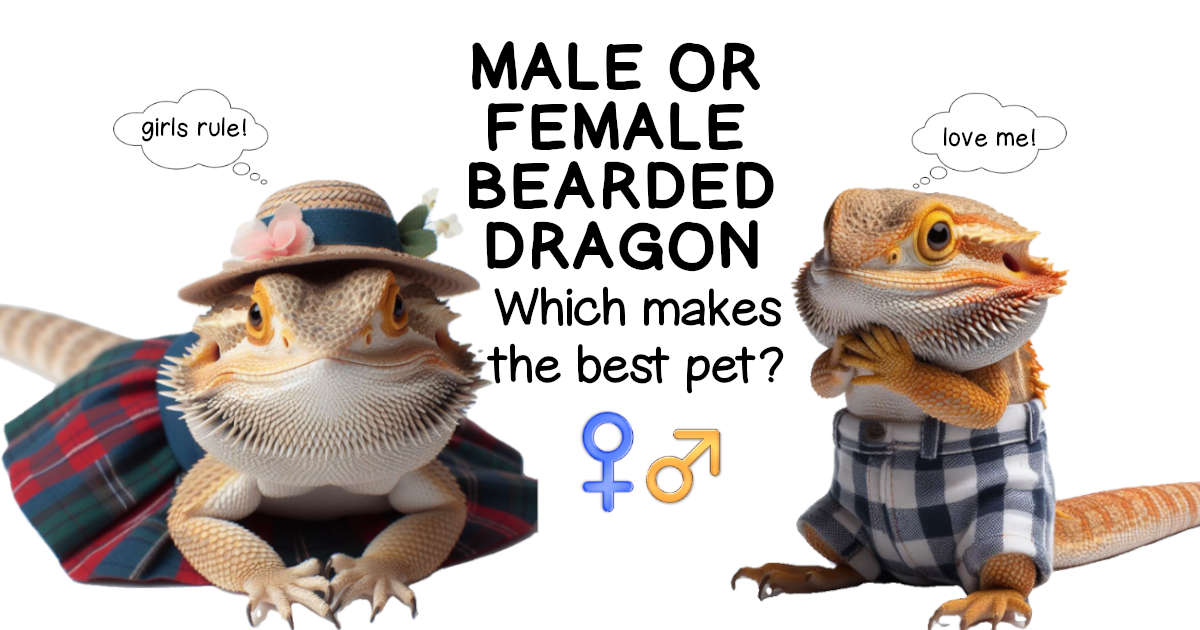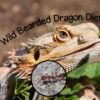Since you are here, chances are you are on the fence about whether to get a male or female bearded dragon, you’re not alone. This decision is more than just picking a pet; it taps into the deeper psychological fabric of our lives, reflecting our identity, desires, and the intricate dynamics of human-animal relationships. Whether you lean towards getting a male or female bearded dragon, each choice comes with its own set of cool quirks and care needs that can match your vibe and lifestyle.
Deciding to get a male or female bearded dragon is a big deal. Your choice is influenced by an array of factors, from the desire for a certain type of companionship to the practicalities of pet care, each reflecting the unique circumstances and aspirations of the individual. Opting to get a male or female bearded dragon is a deeply personal decision, shaped by the intricate web of human desires, social influences, and the longing for a meaningful connection with another living being. It’s all about finding that perfect match.
So, as we dive into the nitty-gritty of whether to get a male or female bearded dragon, we remember, this choice is a reflection of you and your world. It’s about connecting with a pet that’s going to share your space, bring a smile to your face, and become a part of your daily adventures. Let’s explore what makes each option unique and find the best fit for your life!

Key Takeaways
- Personal preferences play a crucial role in choosing between a male or female bearded dragon.
- Both genders require attentive housing and care, aligning closely with their natural habitat.
- Understanding each gender’s distinct behavioral traits assists in choosing the right pet partner.
- Differences include dominance and territorial behaviors, and health issues related to gender.
Jump To…
Differences Between Male and Female Bearded Dragons
Bearded dragons exhibit distinct physical characteristics and behaviors that vary by sex, making the understanding of their anatomy and natural habits important for potential owners.
Size and Appearance
Male bearded dragons often grow larger than females, typically reaching sizes of 18 to 24 inches long. They also exhibit distinctive physical traits such as broader heads and more pronounced beard display, especially during mating season or when asserting dominance. Females are usually smaller, with less prominent beards and a more streamlined head shape. Identifying the sex of a bearded dragon, a process known as sexing, can be done by looking at the shape of the head, width of the base of the tail, and presence of femoral pores.
| Sex | Head Shape | Beard Size | Tail Base | Size |
|---|---|---|---|---|
| Male | Broader | Larger | Thicker | Larger |
| Female | Narrower | Smaller | Slimmer | Smaller |
Males have larger femoral pores than females and they become particularly active during breeding season. Males also have a hemipenes tucked away at the base of their tail.
Bearded Dragon Behavior & Temperament
It’s important to note that the behavior of individuals can vary, and interaction with the owner can influence their behavior over time. That being said, the temperament of male and female bearded dragons can differ, with males generally being more territorial and potentially aggressive, especially during the breeding season. Females may exhibit a more docile behavior.
Behaviors and communication are an interesting factor to consider when deciding whether to get a male or female bearded dragon. Bearded dragons have their own ways of communicating with certain behaviors are typically exhibited by males, while others are more characteristic of females.
Bearded dragons have distinct breeding seasons, and their behavior can change during these times. Males may become more territorial and exhibit more pronounced behaviors such as head bobbing to assert dominance or attract mates. Females, on the other hand, may show signs of gravidity (being pregnant with eggs), which requires special consideration from pet owners, including providing a suitable nesting area for egg-laying and potentially increased nutritional support (Howard & Jaensch, 2021).
Reproductive Considerations
When choosing to get a male or female bearded dragon reproductive differences are significant. Both sexes have their own unique health issues that can arise due to their physiological differences.
Female bearded dragons have their own reproductive challenges. Beyond dystocia and egg-binding, females can suffer from follicular stasis, where eggs develop but are not laid, leading to potential life-threatening conditions.
Additionally, repeated egg-laying cycles can deplete calcium reserves, increasing the risk of metabolic bone disease, a common issue in captive bearded dragons that affects bone health and strength. Ensuring a diet rich in calcium and providing UVB lighting to facilitate vitamin D3 synthesis is critical for all bearded dragons, certainly females, especially during the breeding season.
Females have the capability to lay eggs, and even without a male, they can produce infertile eggs. Considering this, females require additional care during the egg-laying process to avoid health issues, such as calcium depletion.
Female bearded dragons need to be provided with an appropriate laying substrate and nesting area during breeding season to support their reproductive needs.
Male bearded dragons have other considerations. Territorial and mating behaviors can lead to stress and aggression. Dominant males like to perch up high in their cage. A male bearded dragon on its own is likely to feel like the dominant male and if it cannot behavior in the manner it is programmed to it will likely feel stress. Stress in male bearded dragons can manifest in decreased appetite, increased susceptibility to infections, and behavioral changes.
The male bearded dragons hemipenes, (paired reproductive organs) are located at the base of the tail. Problems can arise if the hemipenes become prolapsed (i.e., they do not retract back into the body after mating or due to injury) and can lead to swelling, infection, or necrosis if not treated promptly. Proper husbandry, including maintaining a clean environment and ensuring the dragon is not overweight, can help prevent hemipene issues.
The wax secretions from their femoral pores will be especially active during breeding season when they will spread their scent where they need to. Femoral pores can become impacted without the right conditions such as humidity and housing or the diet is high in fat. Abrasive rocks, branches and the right substrate can enable a bearded dragon to take care of their own grooming needs.
When choosing to get a male or female bearded dragon keep in mind both face general health issues such as parasitic infections, respiratory conditions, and nutritional deficiencies. Proper hygiene, a balanced diet, and appropriate temperature gradients within their enclosure are fundamental to preventing many common health problems.
When deciding to get a male or female bearded dragon, consider the distinct health challenges each sex may face. Regardless of the choice between a male or female bearded dragon, commitment to understanding and meeting their unique needs is key to fostering a healthy and enriching life for these captivating pets.
Housing Requirements
When deciding whether to get a male or female bearded dragon, consider if you will be housing multiple dragons together. Understanding their social interactions is crucial to keeping bearded dragons together.
Bearded dragons are not inherently social creatures in the same way as many mammals; they do not form packs or family units. Their interactions in the wild are primarily for mating purposes or territorial disputes, which can influence their behavior in captivity.
Housing Males: When two or more males are kept in the same enclosure, they will compete for dominance, leading to stress, aggression, and even physical harm. Rearing male bearded dragons together from babies will not change their behavior towards each other once they become sexually mature.
This aggressive behavior can be exacerbated during the breeding season, as males become more territorial and may attempt to assert dominance more frequently. Even visual contact with other males or females in separate enclosures can sometimes trigger aggressive behaviors, such as head bobbing, black bearding, and glass surfing.
Their aggression can result in issues such as chronic stress, injuries including loss of body parts (e.g. toes, leg, tail) or even death.
In addition, even when not in the same enclosure, if more than one male is kept they should be kept in separate areas to reduce stress. They are quite capable of detecting another bearded dragon.
Females: Females tend to be more tolerant of each other than males, but this does not mean they can always be safely housed together. Overcrowding, competition for resources (such as basking spots, food, and hiding places), and individual personality differences can still lead to stress and aggression among females.
While less common than in males, females can exhibit territorial behaviors, especially if the enclosure is too small or inadequately set up to provide multiple basking spots and hiding areas.
Mixed-Gender Housing: Keeping males and females together can lead to constant breeding attempts by the male, which can stress and physically exhaust the female, potentially leading to health issues like egg-binding or depletion of body reserves. Continuous breeding attempts can also result in aggression if the female is not receptive.
It is possible to house more than one bearded dragon together but the right conditions need to be provided.
Diet and Nutrition
When choosing to get a male or female bearded dragon their nutritional needs stands out, particularly in relation to their reproductive status and activities.
This article provides a glimpse of the dietary differences between male and female bearded dragons, highlighting some of their unique nutritional needs based on their sex and reproductive roles. More detailed information on bearded dragon diets can be found in the Diets section.
Female Bearded Dragons: The nutritional needs of females are significantly influenced by their reproductive cycle, particularly during the breeding season when they prepare for egg production. The process of developing and laying eggs demands a substantial amount of calcium and energy. To get through this time female bearded dragons need a calcium-rich diet with sufficient nutrients. A deficiency in calcium can lead to health issues such as metabolic bone disease or complications during egg-laying. In addition to calcium, females may benefit from increased protein and other nutrients to support the energy-intensive process of reproduction.
Male Bearded Dragons: While males do not face the same reproductive demands as females, their diet plays a crucial role in maintaining their health and supporting their behaviors. For example, males have very active femoral pores during breeding season. A diet with the right amount of in vitamin A is beneficial for males, as it supports the health and function of their skin and subsequently their pores. However, vitamin A is also required for females.
Wild, mature bearded dragon males (Pogona barbata) were found to be primarily herbivorous. This suggests a possible lesser requirement for protein compared to females, especially during the breeding season when females might require higher levels of protein for reproduction (Wotherspoon and Burgin, 2016). The dietary shift in adult males to a more herbivorous diet implies that, in captivity, male bearded dragons might not need as much protein-rich food (such as insects) as females, particularly during times when females are preparing for egg production.
Considerations to Get a Male or Female Bearded Dragon: Conclusions
Choosing between a male or female bearded dragon is more than just a decision about a pet; it’s about finding a companion that resonates with your own personality, lifestyle, and emotional needs. Whether you’re drawn to the vibrant assertiveness of a male bearded dragon or the gentle demeanor of a female bearded dragon, this choice reflects your desire for a specific kind of connection with your reptilian friend.
A male bearded dragon may bring a dynamic presence into your home with their territorial displays, while a female bearded dragon might offer a calmer companionship. Knowing this helps you align your choice with your expectations from pet ownership. Each bearded dragon, male or female, comes with its unique personality and set of behaviors, making the decision deeply personal and subjective.
Choosing a male or female bearded dragon is about finding the right fit for your home—a companion that complements your environment and enriches your daily life. It’s about anticipating the joy and challenges that come with either a male or female bearded dragon and embracing them as part of your family. As you navigate this choice, remember that the bond you’ll form with your bearded dragon, whether male or female, is a testament to the unique companionship that pets bring into our lives.
FAQs
Are male or female bearded dragons better?
Whether a male or female bearded dragon is “better” depends on your personal preferences, lifestyle, and what you’re looking for in a pet. Both genders have unique qualities and care requirements. Males may display more territorial behaviors, while females might have additional reproductive health needs.
How does gender affect a bearded dragons behavior?
Male bearded dragons are known to be territorial, often staking out their space, while females generally show less territorial aggression. The temperament can vary with each individual, but males may assert dominance more frequently than females.
Do male or female bearded dragons grow faster?
There is no significant difference in the growth rate of bearded dragons based on gender during their early life stages. However, adult males typically grow to be larger than females.
References
Howard, J., & Jaensch, S. (2021). Haematology and plasma biochemistry reference intervals in wild bearded dragons ( Pogona vitticeps ). Australian Veterinary Journal.
Wotherspoon, D., & Burgin, S. (2016). Sex and ontogenetic dietary shift in Pogona barbata, the Australian eastern bearded dragon. Australian Journal of Zoology, 64(1), 14.





